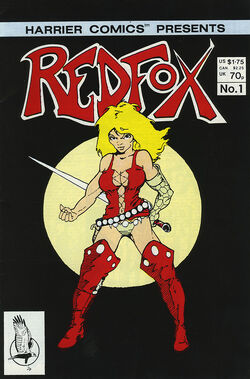
Redfox issue 1.
Redfox is a humorous sword and sorcery comic created primarily by a writer-artist who worked under the pseudonym of Fox, later joined by writer and editor Chris Bell. Initially appearing as a gag strip, it ultimately evolved into a twenty-issue bi-monthly series.
Publication history[]
Redfox started out as a three-panel gag strip in the role-playing fanzine Dragonlords, for which Fox was a house artist; he created the first strip as part of a debate about whether or not the fanzine should show scantily-clad women on its covers. The strip was popular enough for Fox to provide additional instalments during the fanzine's run.[1]
In 1984, after Dragonlords folded, Fox expanded Redfox into a full comic book which he self-published; after the first issue he teamed up with former Dragonlords contributor Mike Lewis, who worked as co-plotter. This self-published run lasted for three issues before Harrier Comics decided to pick up Redfox as a bi-monthly title; the Harrier run began with revised versions of the first three issues.[1]
The ninth issue of Harrier's anthology title Swiftsure, which was published at the same time as Redfox issue 4, [2] included a short prequel to Redfox entitled "Fair Exchange: An Origin of Sorts", which showed how the main character began her adventures.
Harrier initially agreed to publish eight issues of Redfox; this was expanded to ten so as to wrap up the current story arc. Bell, Fox and others set up their own production company, Valkyrie Press, which handled the comic from issue 11 onwards.[3][4]
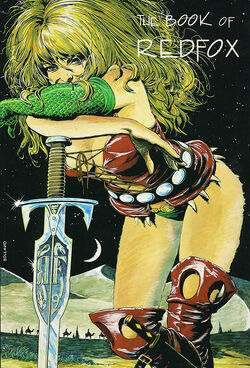
The first Redfox collected edition. Cover by Brian Bolland.
Redfox ended with issue 20, dated June 1989. In her editorial for the final issue, Chris Bell announced that she was retiring from writing and editing the series partly due to having a baby, and that novelist Mary Gentle would take over writing; issue 21 had been scripted and partially drawn,[5] but was left unpublished.
Other projects mentioned in the issue were a spin-off miniseries about the character Whitefox, something that Fox had already decided against by that point; a plan "to collect the adventures of Whitefox into a separate graphic novel" (it is unclear from this description whether the book would have contained new material, or instead been a compilation of already-published stories); and a prequel about the early life of Redfox's sidekick Lyssa the Axe, which had already been scripted as a comic but at the time was looking more likely to be published as a novel.[6] None of these spin-offs reached fruition.
During its run, Redfox was partially collected across two trade paperbacks. The Book of Redfox collected the first four issues and the Swiftsure story, with an introduction by Eleanora Fagan; while Redfox Book II: The Demon Queen collected issues 5 to 10 (omitting a text story from issue 5), with an introduction by Neil Gaiman. Issues 11 to 20 were never collected.
Creative team[]
Fox worked on the art and story for a large portion of the comic. However, he worked with a raft of inkers and co-writers through the comic's run; sometimes his co-writers shared a story credit with him, while at other times he was credited with the story and the co-writer with the script; in some issues, meanwhile, the names are given without any specific roles (for example, issue 2 has the credits "a Fox/Mike Lewis production").
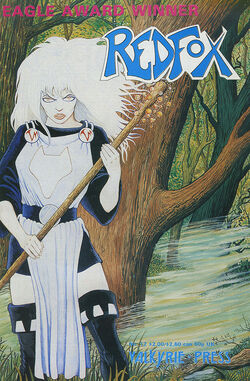
Cover of Redfox issue 12, showing the character Whitefox. This was one of the covers to be coloured by Shelagh Lewins.
The first co-writer to work on Redfox was Mike Lewis, who joined with issue 2 (although the Harrier edition of issue 1 credits him with "additional dialogue"). With issue 6 Lewis was replaced as co-writer by Cat Leslie, who was joined by Chris Bell for issue 7. From issue 8 Leslie left the team, with Fox and Bell being the sole writers. In issues 15 and 16 Fox no longer received a writing credit, with the stories instead credited entirely to Bell.
In issue 17 Fox was credited with story and Bell with art, but the next issue again had Bell credited as sole writer. Issue 18 (which began with a tongue-in-cheek description of the "Jones-Gaiman Theory of Infinite Universe Behaviour") credited Fox and Bell with the story, Diana Wynne Jones was story consultant and Neil Gaiman with "complications". The story in issue 20 was credited to Bell and Gaiman. Sole writing credit on the Swiftsure story, meanwhile, went to Martin Lock.
As noted above, Mary Gentle completed a script for a twenty-first issue that was never published.
Carl Cropley is credited with "interior decoration" in issue 1 and "art assist" in issue 4 and the Swiftsure story, but beyond this, Fox provided all interior art from issues 1 to 5. From issue 6 he shares an art credit with Dave Harwood, who provided the inks.[7] In issue 12 Harwood left, with Tony O'Donnell taking over inking duties.
Issue 14 was the only issue of Redfox that did not contain Fox's artwork. Instead, Tony O'Donnell teamed up with guest artist Matthew Meadows; Fox returned from issue 15 onwards. After O'Donnell left, issue 17 was inked by Andrew Haddelsey and 18 and 19 by Vincent Danks. Finally, SMS provided pencils for five pages of issue 20.
Story[]
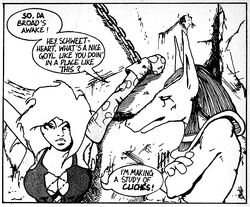
Redfox meets Ankhl in issue 1: an example of the broad comedy to be found in the early Redfox.
The short story from Swiftsure, entitled "Fair Exchange: An Origin of Sorts", sees Redfox working as a barmaid. She meets a weary adventurer named Sirana; as both women are tired of their jobs they decide to switch places, with Sirana training Redfox to use a sword so that she can set off on her own. Wandering the landscape, Redfox encounters such characters as the fighter Lyssa the Axe, the wizard Estaque and the friendly monster Trog.
The early Redfox varied wildly in tone. "Fair Exchange" is a lighthearted example of its genre, but lacks overt comedy - aside from a single-panel cameo from Groo the Wanderer, a Conan spoof created by Sergio Aragonés. The first issue of the ongoing series, meanwhile, is an all-out send-up, full of anachronistic gags and jabs at the convetions of sword and sorcery.
As the series progressed and its world and characters developed, it relied less on this parodic element. The storyline beginning in issue 5 largely ditched comedy for melodrama: in a twist echoing both The Lord of the Rings and the "Dark Phoenix Saga" from X-Men, it was revealed that Redfox's magical ring had left her open to influence from an evil entity named Zebethyial the Demon Queen. Zebethyial caused Redfox's persona to take on a Jekyll and Hyde element; after Redfox went on a pair of killing sprees, it was up to the various friends she had made during her adventures to band together and defeat Zebethyial.
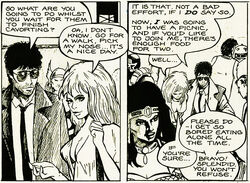
Cameos were a running gag in Redfox. Here Redfox meets the god Griff, who bears a striking resemblence to Neil Gaiman; nearby are Marvel's Thor, Judge Dredd and a Dalek.
The next few issues followed Redfox and her surviving friends as they recovered from their battle with Zebethyial and coped with their new reputation as legendary heroes. Some characters went off on their own adventures, allowing certain issues to focus on members of the supporting cast rather than the heroine.
Even when the comic moved away from broad comedy, it retained a fondness for including characters from other comics in the backgrounds of panels, particularly bar scenes. Characters referred to in this way include Obelix, Luther Arkwright, Mister X, Torquemada, Black Orchid, Cutey Bunny (and her co-star Ashtoreth), the Phantom Stranger and Judge Dredd; also spotted are Salacious B. Crumb, a Dalek and Neil Gaiman.[8]
The final issue introduced a second Demon Queen, frozen in ice but poised to escape; presumably, this plot thread would have been continued had the comic not ended.
Characters[]
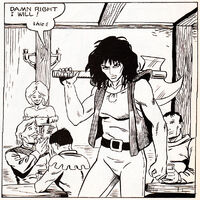
Lyssa the Axe.
Redfox is the heroine of the series: a feisty barmaid-turned-barbarian who is a skilled fighter, but doesn't like to inflict too much injury on her foes.
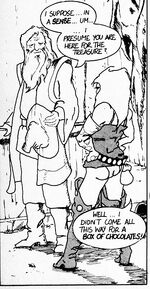
Redfox and Estaque.
Lyssa the Axe is Redfox's burly, mead-swilling sidekick.
Trog is a simple-minded but good-natured monster encountered by Redfox in the Tomb of Pthud. He later receieves a charm that allows him to take on human form.
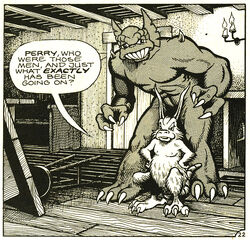
Trog and Ratty.
Estaque is an elderly, somewhat bumbling wizard who becomes Redfox's mentor.
Whitefox is a clone of Redfox created through Estaque's magic. On the comic's full-colour covers she resembles an albino version of her "elder sister", with pale skin, white hair and pink eyes; in the black-and-white pages of the comic itself the only physical difference is that Whitefox has paler eyes. In terms of personality, she is rather more introverted than Redfox.
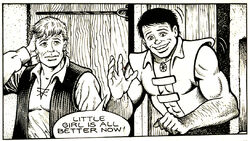
Perry, alongside Trog in his human form.
Ratty is the nickname of Shoquastikan, a small, sarcastic creature that lives with Estaque.
Demon Queen Zebethyial is the most prominent antagonist in the series, even though she appears in only a few issues. A narrative caption in issue 9 informs us that she "was not evil, just totally self centred"; growing bored after having been trapped in limbo for thousands of years, upon escaping from her prison, she used her powers over people's emotions to turn Redfox into a ruthless murderer.
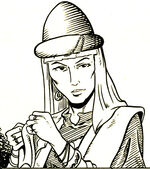
Lady Olga
Ankhl is a jackal-headed creature who lives in the Tomb of Pthud; he resembles the Egyptian god Anubis and talks like Edward G. Robinson. He is later revealed to be a visitor from another dimension, with a very different true form...
Perry is an innkeeper who takes Redfox and her friends under his wing.
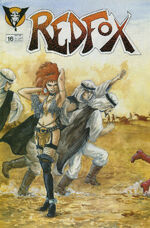
The cover of issue 16, showing Cherry alongside the followers of Vishna.
Lady Olga de Botha y Paranoia is a noblewoman who hires Redfox and Lyssa as bodyguards. The three of them are kidnapped by worshippers of Vishna (who are obliged to say "Vishna be praised" every time their deity is mentioned, in probable homage to a running gag from Carry On, Follow that Camel). Olga later marries the leader of her kidnappers, Al El Alla.
Cherry is an imposter who claims to be Redfox so as to attract attention in pubs, much to the chagrin of the real Redfox. She takes to wearing a chainmail bikini top in the manner of the Marvel character Red Sonja, suggesting that she was intended as a parody of typical sword and sorcery heroines.
Griff is the deity who created Redfox's world. Although often invoked, he does not appear until the very last issue, when Redfox meets a strange man who hints that he is none other than Griff himself - and who is drawn to look like Neil Gaiman.
Reception[]
In the British section of the 1987 Eagle Awards, Redfox won the award for Favourite New Comic, with certain characters being nominated in other sections: Lyssa, for Most Deserving of Own Title (losing to Halo Jones) and Zebethyial, for Favourite Villain (losing to Torquemada).[9].
Due to the skimpy outfits worn by its lead, along with several other female characters, the comic was accused of sexism by certain readers; this complaint was often brought up dismissively in the letters column. Eleanora Fagan's introduction to the first trade jokingly remarked that it is the "weaker male sex" that is the true target of the comic's chauvinism: "One criticism of Fox's work that has inevitably been voiced is that it is overtly sexist. Well, I do have to agree that Fox needs to develop a more sympathetic attitude towards his male characters..."
The comic was popular enough to spawn a modest line of merchandise. From issue 12 onwards, the subscription section began advertising sweaters and T-shirts with the Redfox logo, and a set of badges featuring characters from the comic. The editorial for the penultimate issue announced that one enterprising reader had designed a set of 25mm gaming miniatures depicting Redfox, Whitefox, Lyssa, Ratty, Trog, Estaque and Zebethyial, and was planning to begin manufacturing them with an initial run of 100 sets, but as the comic ended shortly afterwards it is unclear as to how well this endeavour did.
Alpha Flight controversy[]
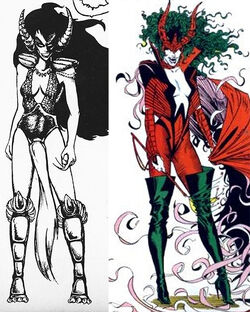
Left: Fox's Demon Queen. Right: Marvel's Dreamqueen. You be the judge.
In the editorial to Redfox issue 17, Chris Bell claimed that the character of the Demon Queen Zebethyial had been stolen by another comic, which she left unnamed at the time:
"She's obviously very popular - popular enough to be worth taking over right down to her fingernails, for use in another comic. Just change two letters of the name, then you can hang on to the costume, the plotline, the design of the speech-bubbles, the way she behaves and even the way she stands. No prizes are being offered by us for this doppelgänger. Non-prizes, in fact, to the publisher, the editors, scripters, penciller, inker, colorist ..... We hope that they may one day feel ashamed of themselves for such a blatant piece of - well, let's be charitable and call it unoriginality, shall we? Not plagiarism, that would be rude; almost as rude as it would be for us to steal someone's ideas without bothering to ask or to acknowledge our creative debt."
The comic in question was Marvel's Alpha Flight, the offending character being named Dreamqueen (created by writer Bill Mantlo and artist Jim Lee). In 2007 Fox himself commented on a Comic Book Resources post about the matter:
"[I]t wasn’t just the visuals, although I don’t recall the details now. I spoke to John Byrne at a convention later that year and he wasn’t surprised to hear about it. Apparently Mantlo had something of a reputation.
And it wasn’t the only time the Demon Queen was used as source material by Marvel. At one point a Demon Princess or Goblin Queen or something like that popped up in X-Men, and while the similarities were more subtle, I knew that Chris Claremont read Redfox, and I have the photos to prove it. So the next time I saw him at a con I asked him whether it was more than a coincidence and he neither admitted nor denied it. He just gave a big smile."[10]
Reportedly, this matter resulted in DC Comics changing the English name of a French character, la Renard Rouge, from "the Red Fox" to "the Crimson Fox".[11]
References[]
- ↑ 1.0 1.1 Editorial, Redfox issue 1
- ↑ Letters, Redfox issue 3
- ↑ Redfox issue 10, editorial
- ↑ http://www.arkeology.org.uk/Editorials/ed_arkeology.html
- ↑ Editorial, Redfox issue 20
- ↑ Letters, Redfox issue 20
- ↑ http://www.garenewing.co.uk/home/writing/tony.php
- ↑ A letter printed in issue 17 identified someone called Ramel Karina in one panel, whoever he or she may be.
- ↑ Editorial, Redfox issue 12
- ↑ http://goodcomics.comicbookresources.com/2007/08/23/comic-book-urban-legends-revealed-117/
- ↑ http://goodcomics.comicbookresources.com/2005/11/17/comic-book-urban-legends-revealed-25/